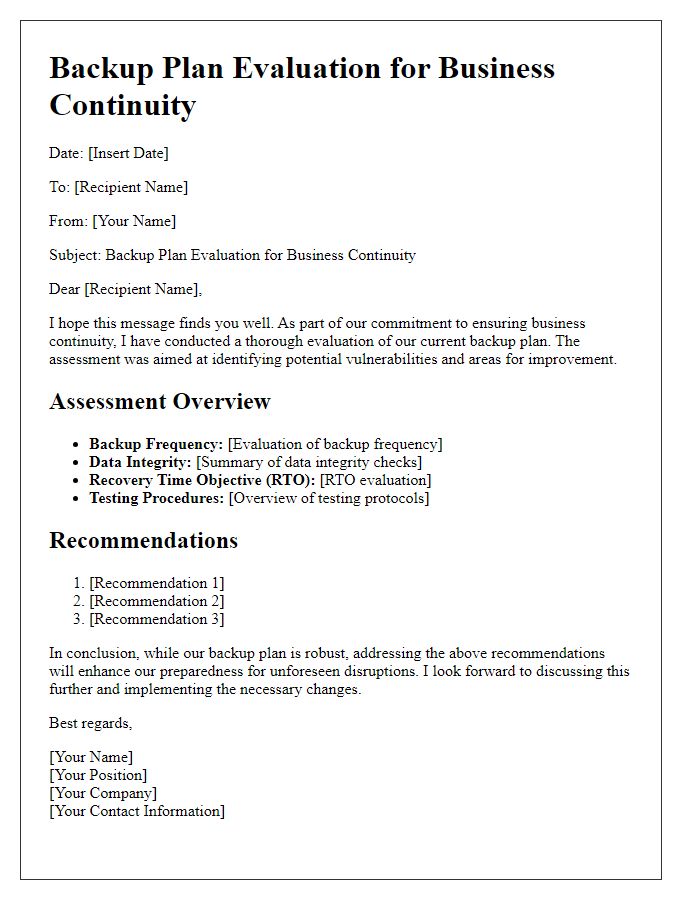In today's digital landscape, ensuring the safety of your data is more critical than ever, and having a robust backup strategy is a key component in achieving that security. Whether you are a small business or a large corporation, validating your backup processes can mean the difference between a minor hiccup and a major data disaster. It's essential to regularly assess your back-up strategies to confirm they are effective, up-to-date, and tailored to your unique needs. Curious to learn more about how to effectively validate your backup strategy? Keep reading!

Purpose and Scope
A comprehensive backup strategy is crucial for data integrity and business continuity, ensuring that critical files and systems remain recoverable in case of unexpected incidents such as cyber-attacks, hardware failures, or natural disasters. The purpose of validating the backup strategy is to ensure that data recovery processes are efficient and effective, confirming that backups (daily, weekly, and monthly frequencies) contain complete and uncorrupted versions of essential data. This includes the validation of ongoing backups stored in secure locations, such as off-site data centers and cloud storage solutions like AWS S3 and Microsoft Azure, to maximize data availability and mitigate risks. The scope encompasses all organizational data types, including databases, application servers, and user files, ensuring that recovery time objectives (RTO) and recovery point objectives (RPO) are consistently met across all platforms. Regular testing of recovery processes and assessments against industry standards, such as ISO/IEC 27001, is imperative to identify potential weaknesses and facilitate continuous improvement of the backup strategy.
Roles and Responsibilities
A comprehensive backup strategy validation process is essential for safeguarding critical data and ensuring business continuity. The designated roles include the Backup Administrator, responsible for implementing and managing the backup systems, which could include solutions like Acronis or Veeam. The Data Owner oversees the identification and classification of sensitive information, ensuring compliance with regulations such as GDPR or HIPAA. The IT Security Officer evaluates the security protocols in place, protecting backups from unauthorized access and potential cyber threats met by phishing attacks or ransomware incidents. Furthermore, the Business Continuity Planner integrates backup strategies into wider emergency response planning, ensuring minimal disruption during data recovery operations. Regular audits by the Compliance Officer assess adherence to policies and effectiveness of backup processes, critical in maintaining operational integrity and capturing changes in regulatory requirements.
Backup Schedule and Retention
A robust backup strategy is crucial for data integrity in organizations. Scheduled backups (daily, weekly, monthly) ensure recent data is preserved, especially for critical systems like servers or databases (e.g., Oracle Database 19c). Retention policies dictate how long each backup is stored (usually 30 days for incremental backups, up to 7 years for archival data), balancing storage costs with data recovery needs. Validation processes, such as regular restoration tests, confirm backup effectiveness, safeguarding against data loss events (like ransomware attacks). Documenting the backup schedule (including specific times and responsible personnel) alongside retention policies helps maintain organizational compliance with regulatory standards (e.g., GDPR, HIPAA). Overall, a comprehensive backup strategy enhances organizational resilience against potential data breaches and system failures.
Data Recovery Process
A robust data recovery process ensures business continuity in the event of data loss. Organizations must perform regular backups, utilizing cloud storage solutions like Amazon S3 or on-premises systems (such as Network Attached Storage). Testing restoration procedures every quarter identifies potential failures in backup files or hardware. Implementing redundancy, using Multiple Backup Locations (for example, geographically diverse data centers) prevents catastrophic data loss during natural disasters. Documenting recovery time objectives (RTO) of two hours and recovery point objectives (RPO) of 15 minutes benchmark the efficiency of the data recovery strategy, allowing for swift operations restoration. Regular audits of these processes, alongside employee training, fortify the resilience of the overall data management strategy.
Testing and Validation Procedures
A comprehensive backup strategy validation process guarantees data integrity and accessibility for organizations. Regular testing (quarterly or bi-annually) involves simulating data recovery scenarios using backup solutions such as Veeam or Acronis. Key performance indicators (KPIs), like Recovery Time Objective (RTO) and Recovery Point Objective (RPO), must be established to measure efficiency. Validation procedures, including random sampling (testing 10% of data sets), assess restoration accuracy. Documentation of each test with timestamps, results, and necessary adjustments is crucial for compliance audits. Furthermore, maintaining an offsite backup (for instance, in a secure cloud environment like AWS or Azure) enhances disaster recovery preparedness, especially for business continuity planning in the event of a data loss incident or cyberattack.
Letter Template For Backup Strategy Validation Samples
Letter template of backup strategy confirmation for operational efficiency

Letter template of backup architecture assessment for performance improvement












Comments